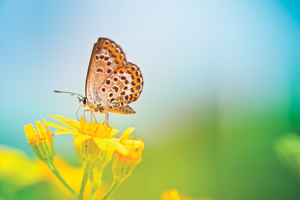BY DOREEN POLLACK
There are many reasons for creating a wildlife habitat. Personal enjoyment, protection of birds, animals and endangered species, improved curb appeal, and building community with neighbors are some of the reasons. One of the biggest benefits is the positive impact it has on the environment.
 Many people spend too much money eradicating creatures from their yards. Unfortunately, that money is often spent on toxic chemicals that can harm wildlife, household pets and even us! When you create a back or front yard habitat, you eliminate the need to artificially control it.
Many people spend too much money eradicating creatures from their yards. Unfortunately, that money is often spent on toxic chemicals that can harm wildlife, household pets and even us! When you create a back or front yard habitat, you eliminate the need to artificially control it.
What can you do to bring nature back into balance and encourage wildlife to become part of your outdoor environment? It’s easy – go natural! By adding native plants (bushes and trees) to an existing landscape and providing four essential elements necessary to create a habitat, you will encourage the birds, bees, butterflies, insects and other creatures to return to your yard.
How to create a habitat:
Habitat is defined by four essential elements: food, water, shelter and space. The foundation of the habitat is the vegetation type that exists on the site. Food sources can include plant material (including roots, pollen and nectar), insects or other animals. If preferred food sources are not available, some species will seek out new sources, such as your pet’s food, your prized tomatoes, bountiful apricot tree, or shrubs. So be sure to plant native species to provide food for the wildlife while keeping them away from your favorite flora.
Using native plants takes less watering, fertilizing and mowing and allows you to feel more connected to your native environment. Once established, many native plants can survive on your area’s annual rainfall. By leaving fallen leaves to decompose around your plants, you might not need to add fertilizer. To attract small creatures and insects, these leaves create shelter, as do vegetation, large rocks, prickly pear cactus, standing dead trees – even debris piles. Beware of crawl spaces under homes and sheds, though. These spaces are notorious for attracting skunks, rock squirrels, woodrats and raccoons.
Deciding what to plant:
Consider your yard’s assets before you purchase any new plants. Make note of shady and sunny areas, spots with good or poor drainage, and challenge points in your landscape. When you shop, look for native plants adapted to those areas. As you create, don’t forget to include places for humans in your backyard wildlife habitat – perhaps a bench near the pond or large rocks to provide a spot for relaxing and watching wildlife, or creating viewing areas from windows or patios.
A backyard composed mainly of native plants becomes a haven for native wildlife. Again, these plants provide food, cover and reproductive sites and require minimal care from homeowners. A great resource is the local university’s Cooperative Extension Office to guide your selection.
Attracting the wildlife you want:
Do butterflies make your heart flutter? Plant a butterfly garden of wildflowers, grasses and shrubs near a shallow pool. Do baby birds and bird song lift your spirits? Install nest boxes and feeders in existing trees and near shrubs or flowers. The Audubon Society web site has useful information about feeding and landscaping to benefit birds.
What about pest control? Consider installing bat boxes or a bee block – bats can eat 3,000 mosquitoes each in one night! Use high-quality bird seed or suet to help prevent birds from kicking the “bad seeds” to the ground, and remember to keep your pet’s food indoors. Generally I prefer growing nectar-producing flowers for hummingbirds and butterflies. These include penstemon, Indian paintbrush, honeysuckle, lantana and columbine.
But don’t forget about the not-so-welcome visitors. Javelina, rock squirrels, rats and mice are attracted to spilled seed from bird feeders and outside pet food. .
In the wild garden, human habitat merges with the native landscape, restoring the balance to the ecological community. In the wild garden, we embrace ourselves as one of the species, not just as separate individuals or families. By inviting nature into your landscape, you create a refuge for wildlife that once freely walked the land. Re-creating this balance will encourage a more natural solution to the problems you once had in the garden. You will use less outside resources, spend less time and less money overall by embracing a natural landscape. Let nature provide what is necessary to create a bio-diverse ecology in your yard. You and Mother Earth will benefit!
RESOURCESwww.az.audubon.org
www.extension.arizona.edu
Doreen Pollack is the Garden Goddess and owner of Down 2 Earth Gardens, providing garden consultations and coaching. Get gardening tips at monthly workshops, on her blog or newsletter. Visit www.down2earthgardens.com to learn more.





